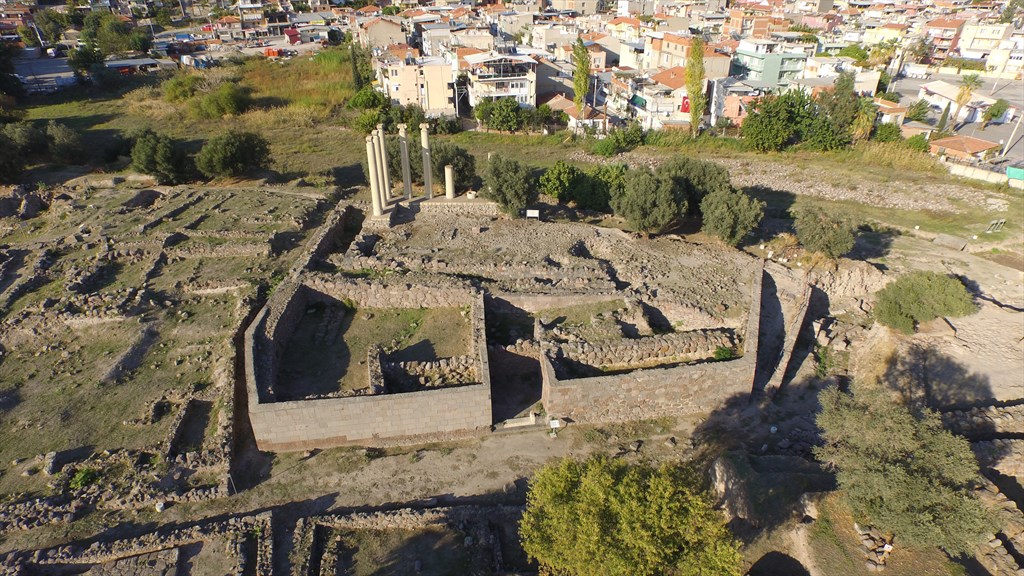Old Smyrna - Bayraklı Höyük
The old city of Izmir (Smyrna) was founded on an islet located in the northeast of the bay, with an area of about one hundred decares. During the last centuries, today's Bornova plain was formed with the miles brought by the floods coming from the Meles River Sipylos (Yamanlar) Mountain and the peninsula turned into a hill. On this mound, now named Tepekule, there is a sample vineyard of the Tekel Directorate's Izmir Wine and Brewery. In the latest excavations, it has been revealed that the settlement areas in İzmir date back to 7000 BC.
The history
Although the history of the city of Smyrna in Bayraklı is estimated to date back to 3000 BC, the latest excavations have only been reached till 3000 BC. Based on the information obtained from the excavations, it was determined that the first settled houses were placed on rocks 3 to 5 meters above the sea at the top of the mound. This first settlement belongs to the Early Bronze Age period. During the Iron Age, İzmir houses consisted of large and small one-room buildings. The oldest house unearthed is dated to 925 BC to 900 BC. This one-room house (2.45 x 4 m), which was unearthed in a well-preserved condition, had mud brick walls and thatched roof. The people of ancient Izmir started to protect their city with a thick wall made of mudbrick around 850 BC. It can be said that since this date, Old Izmir has acquired a city-state identity. It is possible that a brain called 'Basileus' ruled the city. Those who carried out the migrations and the city dignitaries were the noble strata. The population living within the city walls was an estimated one thousand people. Most of the people belonging to the city state lived in the surrounding villages. In these villages, there were fields, olive trees, vineyards, potter and stonemason workshops of Old Izmir in this age. Livelihood was provided by agriculture and fishing. The most important sacred structure of the city was the Temple of Athena. The oldest ruin of this temple preserved until today is dated between 725-700 BC. The bright period of the old Izmir coincides with the years between 650-545 BC. This period, which lasts about a hundred years, constitutes the most powerful period of the entire Ionian civilization. During this period, we see that İzmir was not content with agriculture but also became a partner in Mediterranean trade. One of the important signs of the bright period in Izmir is that the writing has started to become widespread since 650 BC. Many of the gifts presented to the goddess Athena have offering inscriptions. The Temple of Athena (640-580 BC) unearthed during excavations is the oldest architectural work in the Eastern Hellenistic world. The oldest and most beautiful column capitals have been found in Izmir so far. The avenues and streets of old Izmir were grid-planned as early as in the second half of the 7th century, the streets and streets stretched from north to south and east to west, with houses generally facing south. This city plan, which would later become the Hippodamos type in the 5th century BC, was essentially known in the Near East. Bayraklı city plan is the earliest example of this kind of urban fabric in the Western world. The oldest parquet-paved road of the Ionian civilization was brought to light in Eski Izmir. The oldest civil architectural work of the Hellenistic world is the beautiful stone fountain built in Eski Izmir in the first half of the 7th century. Tantalus Tomb, once rising on Yamanlar Mountain, is a beautiful representative of tholos-shaped monumental tombs. This monumental work, known as the Tantalus Tomb, must be the tomb of Basileus or Tyran, who ruled in Old Izmir between 520-580 BC. The wealth and development of Izmir set the neighboring Lydians into action and they went to war with the people of Izmir. In 610-600 BC, the Lydian armies captured Izmir and destroyed the city. However, the people of Izmir managed to rebuild their city. The collapse of old Izmir is one of the results of the Persian invasion in Anatolia. While the Persian Emperor's armies were advancing in Anatolia, he wanted the coastal cities of the Aegean to support him against the Lydian kingdom. After capturing Sardes, the capital of the Persian Emperor Lydia, in order to punish the coastal cities of the Aegean that did not comply with this request, he attacked Izmir along with other coastal cities. As a result of the attack of the Persian Armies, İzmir was destroyed in 545 BC. After this destruction, there was no more urban settlement in the settlement area in Bayraklı.







Comments
No comment left, would you like to comment?